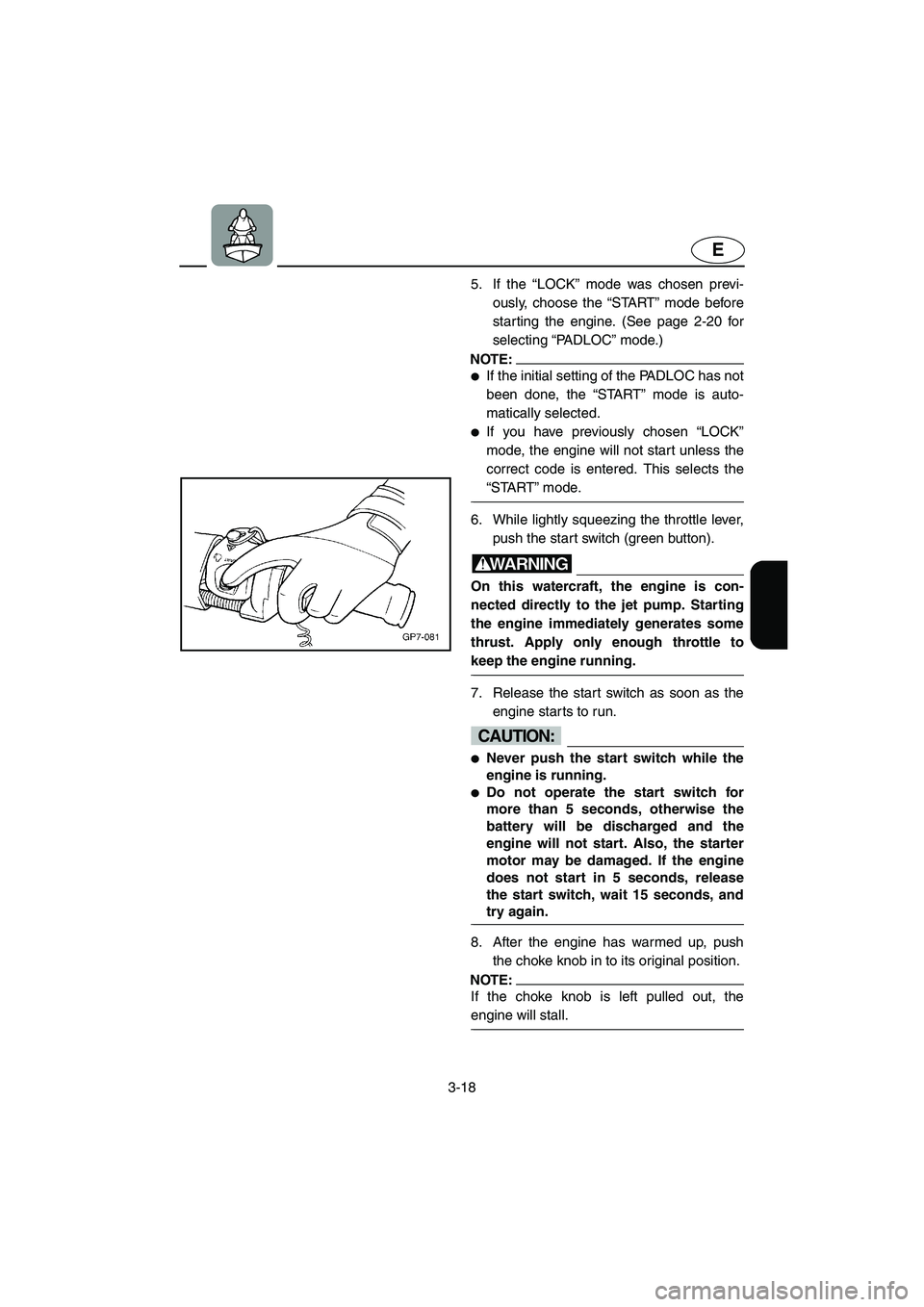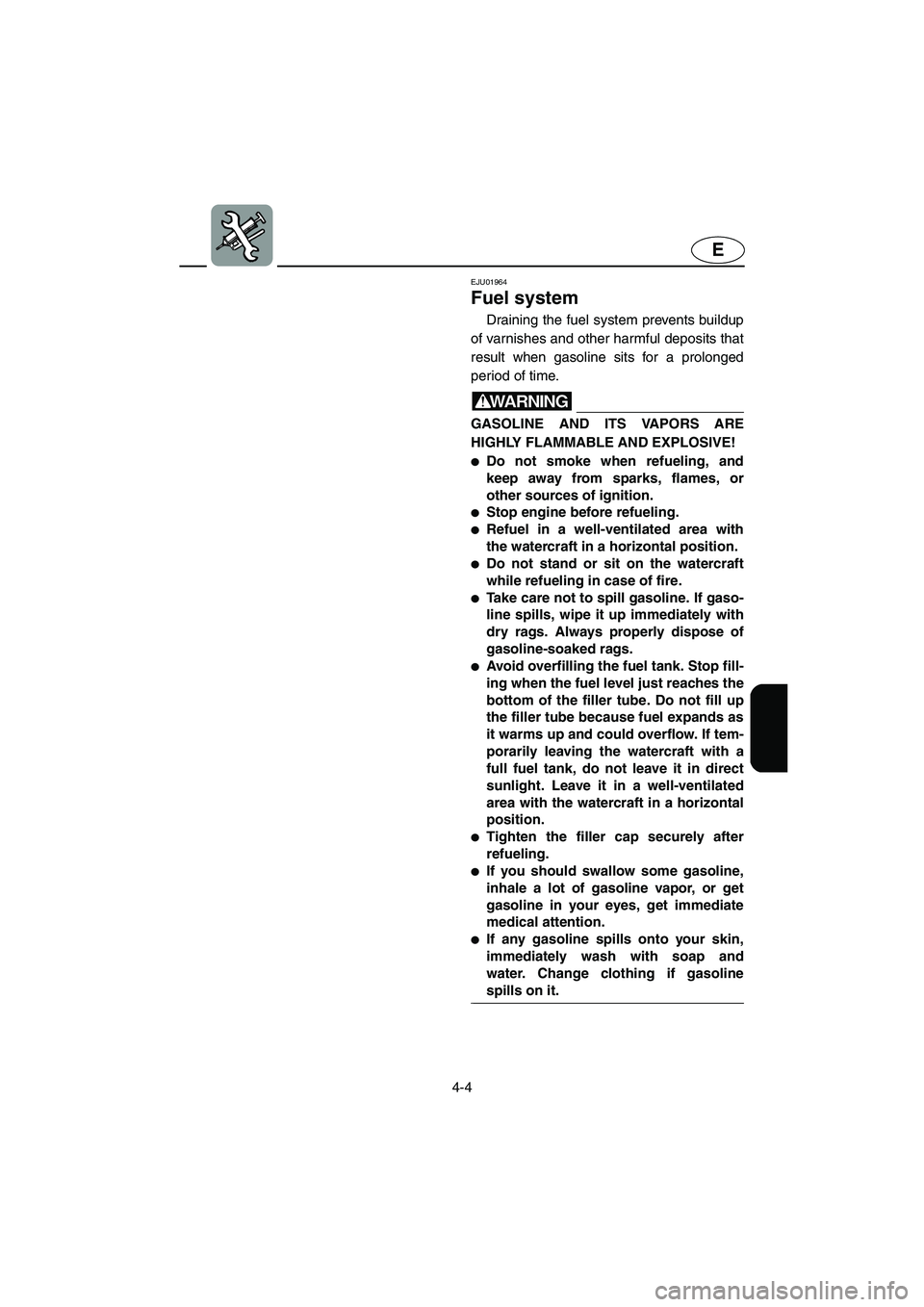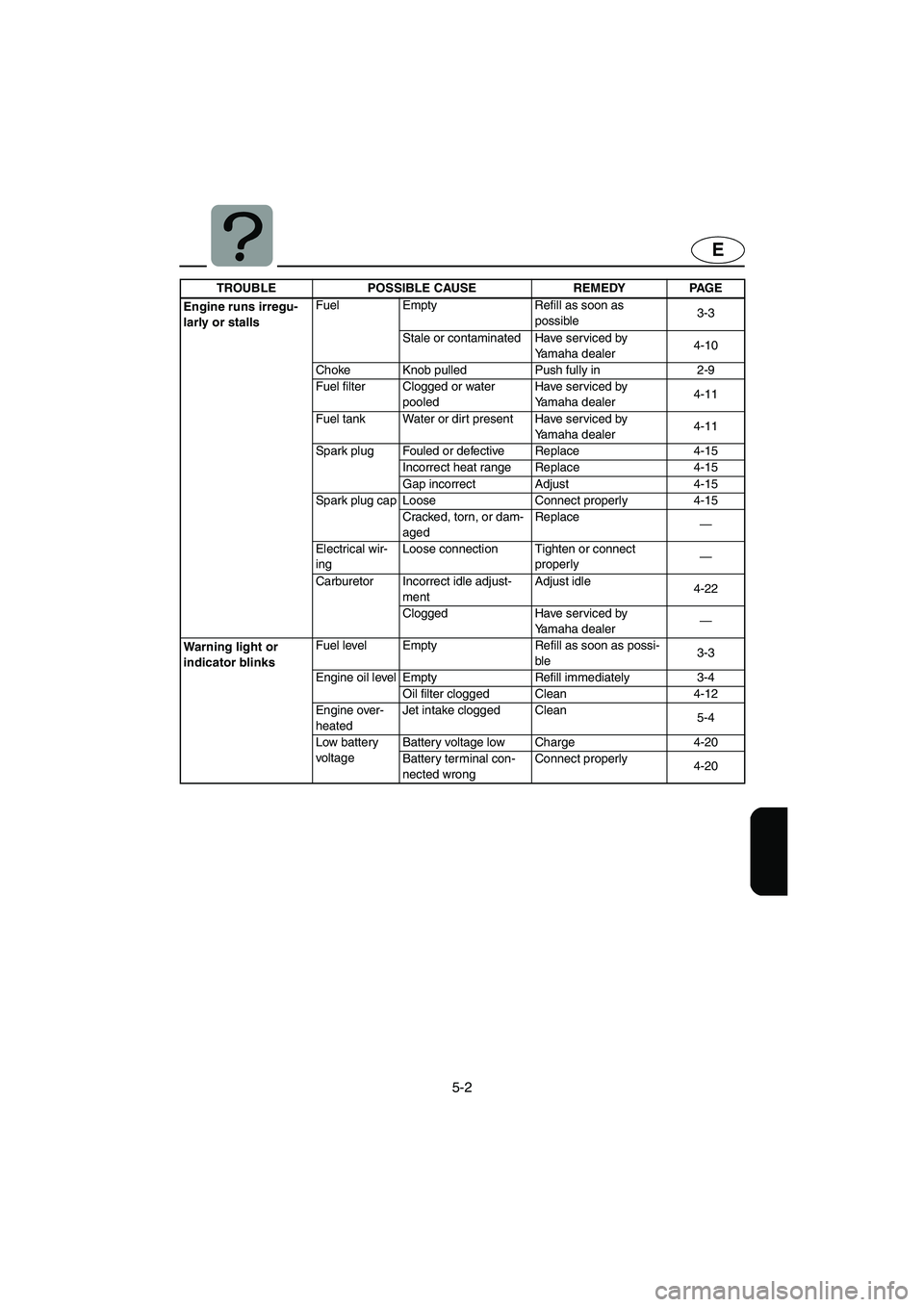Page 75 of 134

3-18
E
5. If the “LOCK” mode was chosen previ-
ously, choose the “START” mode before
starting the engine. (See page 2-20 for
selecting “PA D L O C” mode.)
NOTE:@ �If the initial setting of the PADLOC has not
been done, the “START” mode is auto-
matically selected.
�If you have previously chosen “LOCK”
mode, the engine will not start unless the
correct code is entered. This selects the
“START” mode.
@
6. While lightly squeezing the throttle lever,
push the start switch (green button).
WARNING@ On this watercraft, the engine is con-
nected directly to the jet pump. Starting
the engine immediately generates some
thrust. Apply only enough throttle to
keep the engine running.
@
7. Release the start switch as soon as the
engine starts to run.
CAUTION:@ �Never push the start switch while the
engine is running.
�Do not operate the start switch for
more than 5 seconds, otherwise the
battery will be discharged and the
engine will not start. Also, the starter
motor may be damaged. If the engine
does not start in 5 seconds, release
the start switch, wait 15 seconds, and
try again.
@
8. After the engine has warmed up, push
the choke knob in to its original position.
NOTE:@ If the choke knob is left pulled out, the
engine will stall.
@
UGU572.book Page 18 Wednesday, August 28, 2002 1:31 PM
Page 77 of 134

3-20
E
EJU01068
Operating your watercraft
EJU01321
Getting to know your
watercraft
Operating your watercraft requires skills
acquired through practice over a period of
time. Take the time to learn the basic tech-
niques well before attempting more difficult
maneuvers.
Operating your new watercraft can be a
very enjoyable activity, providing you with
hours of pleasure. However, it is essential to
familiarize yourself with the operation of the
watercraft to achieve the skill level neces-
sary to enjoy riding safely. Before operating
this watercraft, read this Owner’s/Operator’s
Manual, the Riding Practice Guide, and all
warning and caution labels on the water-
craft. Pay particular attention to the safety
information on pages 1-9 to 1-16. These
materials should give you an understanding
of the watercraft and its operation.
Remember: This watercraft is designed to
carry the operator and up to 3 passengers.
Never exceed the maximum load limit or
allow more than 4 persons (or 3 persons if a
water-skier is being pulled) to ride the water-
craft at one time.
EJU01070
Learning to operate your
watercraft
Before operating the watercraft, always
perform the pre-operation checks listed on
page 3-5. The short time spent checking the
watercraft will reward you with added safety
and reliability.
Check all local laws before operating your
watercraft.
Operate defensively at safe speeds and
keep a safe distance away from people,
objects, and other watercraft. Select a wide
area to learn in, where you have good visi-
bility and light boat traffic.
Use the buddy system—operate with
someone nearby. Scan constantly for peo-
ple, objects, and other watercraft. Be alert
for conditions that limit your visibility or block
your vision of others.
Attach the engine shut-off cord (lanyard)
to your wrist and keep it free from the han-
dlebars so that the engine stops if the opera-
tor falls off.
Wear a personal flotation device (PFD).
All riders must wear an authority-approved
PFD that is suitable for personal watercraft
use. Maximum load: 300 kg (662 lb)
Load is the total weight of cargo, opera-
tor and passengers.
UGU572.book Page 20 Wednesday, August 28, 2002 1:31 PM
Page 97 of 134

4-4
E
EJU01964
Fuel system
Draining the fuel system prevents buildup
of varnishes and other harmful deposits that
result when gasoline sits for a prolonged
period of time.
WARNING@ GASOLINE AND ITS VAPORS ARE
HIGHLY FLAMMABLE AND EXPLOSIVE!
�Do not smoke when refueling, and
keep away from sparks, flames, or
other sources of ignition.
�Stop engine before refueling.
�Refuel in a well-ventilated area with
the watercraft in a horizontal position.
�Do not stand or sit on the watercraft
while refueling in case of fire.
�Take care not to spill gasoline. If gaso-
line spills, wipe it up immediately with
dry rags. Always properly dispose of
gasoline-soaked rags.
�Avoid overfilling the fuel tank. Stop fill-
ing when the fuel level just reaches the
bottom of the filler tube. Do not fill up
the filler tube because fuel expands as
it warms up and could overflow. If tem-
porarily leaving the watercraft with a
full fuel tank, do not leave it in direct
sunlight. Leave it in a well-ventilated
area with the watercraft in a horizontal
position.
�Tighten the filler cap securely after
refueling.
�If you should swallow some gasoline,
inhale a lot of gasoline vapor, or get
gasoline in your eyes, get immediate
medical attention.
�If any gasoline spills onto your skin,
immediately wash with soap and
water. Change clothing if gasoline
spills on it.
@
UGU572.book Page 4 Wednesday, August 28, 2002 1:31 PM
Page 121 of 134

5-2
E
Engine runs irregu-
larly or stallsFuel Empty Refill as soon as
possible3-3
Stale or contaminated Have serviced by
Yamaha dealer4-10
Choke Knob pulled Push fully in 2-9
Fuel filter Clogged or water
pooledHave serviced by
Yamaha dealer4-11
Fuel tank Water or dirt present Have serviced by
Yamaha dealer4-11
Spark plug Fouled or defective Replace 4-15
Incorrect heat range Replace 4-15
Gap incorrect Adjust 4-15
Spark plug cap Loose Connect properly 4-15
Cracked, torn, or dam-
agedReplace
—
Electrical wir-
ingLoose connection Tighten or connect
properly—
Carburetor Incorrect idle adjust-
mentAdjust idle
4-22
Clogged Have serviced by
Yamaha dealer—
Warning light or
indicator blinksFuel level Empty Refill as soon as possi-
ble3-3
Engine oil level Empty Refill immediately 3-4
Oil filter clogged Clean 4-12
Engine over-
heatedJet intake clogged Clean
5-4
Low battery
voltageBattery voltage low Charge 4-20
Battery terminal con-
nected wrongConnect properly
4-20 TROUBLE POSSIBLE CAUSE REMEDY PAGE
UGU572.book Page 2 Wednesday, August 28, 2002 1:31 PM